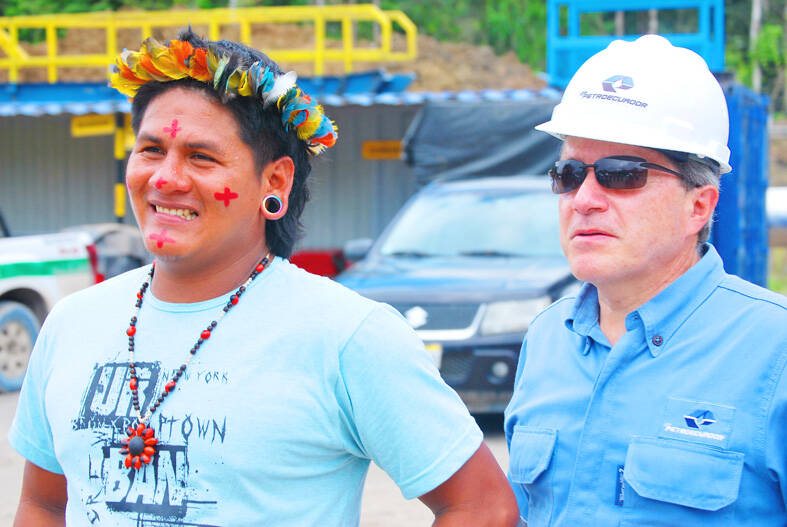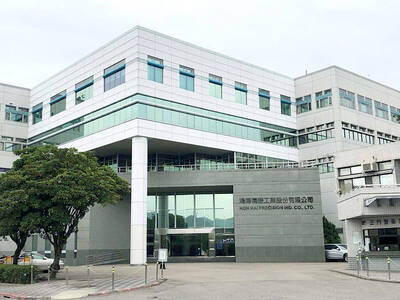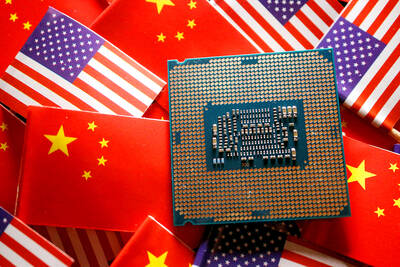A group of indigenous Waorani women give a war cry warning that environmentalists are not welcome in their part of the Ecuadoran Amazon, where an oil field operates partly on a protected reserve.
“We will not allow kowori [strangers] ... to enter,” said Waorani leader Felipe Ima, translating the belligerent words of a group of seven women from the Kawymeno community that supports oil extraction at the nearby Ishpingo field.
The community is pitted in a battle of wills against environmental group Yasunidos, which has been fighting for a decade for a referendum on leaving the oil underground.

Photo: EPA-EFE
In May, the Ecuadoran Constitutional Court allowed the request, and a plebiscite has been scheduled for next month.
Escorted by a warrior wielding a spear, the women from Kawymeno hold hands and dance in little clothing and feather crowns at the entrance to Ishpingo A platform.
They demand that any consultation should be with “the owners” of the land, and not with anyone that is “not even from the territory,” Ima said.
In Ecuador, the constitution recognizes indigenous people’s “collective ownership of land as an ancestral form of territorial organization.”
However, the state maintains control over anything under the soil. Ishpingo, together with the nearby fields of Tiputini and Tambococha, form the so-called ITT block, or block 43, which holds an estimated 282 million of the South American country’s proven crude reserves of 1.2 billion barrels.
Extraction at Tiputini and Tambococha started in 2016 after years of fraught debate over whether to drill inside the Yasuni National Park. This came after the government of then-Ecuadoran president Rafael Correa failed to persuade the international community to pay former OPEC member Ecuador US$3.6 billion not to exploit the ITT block to protect the Amazon and help curb climate change.
In April last year, the government announced pumping had also started at Ishpingo.
At the site protected by women in the dense, green jungle, stands one of 12 platforms of the ITT block that contributed 57,000 barrels per day to Ecuador’s total production of 464,000 barrels per day from January to April.
It is in the Yasuni National Park, a biosphere reserve that houses about 2,000 tree, 610 bird, 204 mammal, 150 amphibian and more than 120 reptile species, the San Francisco University of Quito said.
The Waorani community of Kawymeno, a journey of about four hours by foot and canoe from Ishpingo, is near the border with Peru.
Its 400 inhabitants have declared themselves defenders of the oil activity and its windfalls they say make up for the absence of government services.
“If there were no oil industry, we would not ... have had education, health, family welfare,” said Panenky Huabe, leader of the village where many work in the oil sector.
Aside from being among the most biodiverse areas on Earth, the 1 million hectare Yasuni park is home to two of the world’s last uncontacted indigenous populations. It also holds oil fields that started operating before the ITT block.
“We see how extraction has been besieging the Yasuni for many years, since the 1970s when exploitation began,” Yasunidos lawyer and spokesman Pedro Bermeo said.
“Basically, the [block] 43 is the only one with a part [of jungle] that remains to be saved,” he said.
However, the referendum has generated deep divisions even among the Waorani, whose 4,800 members own about 800,000 hectares of jungle in the provinces of Orellana, Pastaza and Napo.
In 2019, the Waorani of Pastaza won a historic court ruling that prevents the entry of oil companies on 180,000 hectares on their territory, but at Ishpingo A in Orellana, oil worker Akao Yetebe — also a Waorani — said “we will continue working,” because “black gold benefits big cities, teachers, education, health, everything.”
State-owned EP Petroecuador is authorized to operate on about 300 hectares of the Yasuni for its ITT block. So far it has used about 80 hectares, generating US$4.2 billion for the state — about US$1.2 billion last year alone.
If the “yes” wins in next month’s referendum, “losses will be substantial” — about US$16.4 billion in projected income, as well as jobs and investments already made, Petroecuador manager Ramon Correa said.

Shares in Taiwan closed at a new high yesterday, the first trading day of the new year, as contract chipmaker Taiwan Semiconductor Manufacturing Co (TSMC, 台積電) continued to break records amid an artificial intelligence (AI) boom, dealers said. The TAIEX closed up 386.21 points, or 1.33 percent, at 29,349.81, with turnover totaling NT$648.844 billion (US$20.65 billion). “Judging from a stronger Taiwan dollar against the US dollar, I think foreign institutional investors returned from the holidays and brought funds into the local market,” Concord Securities Co (康和證券) analyst Kerry Huang (黃志祺) said. “Foreign investors just rebuilt their positions with TSMC as their top target,

REVENUE PERFORMANCE: Cloud and network products, and electronic components saw strong increases, while smart consumer electronics and computing products fell Hon Hai Precision Industry Co (鴻海精密) yesterday posted 26.51 percent quarterly growth in revenue for last quarter to NT$2.6 trillion (US$82.44 billion), the strongest on record for the period and above expectations, but the company forecast a slight revenue dip this quarter due to seasonal factors. On an annual basis, revenue last quarter grew 22.07 percent, the company said. Analysts on average estimated about NT$2.4 trillion increase. Hon Hai, which assembles servers for Nvidia Corp and iPhones for Apple Inc, is expanding its capacity in the US, adding artificial intelligence (AI) server production in Wisconsin and Texas, where it operates established campuses. This

US President Donald Trump on Friday blocked US photonics firm HieFo Corp’s US$3 million acquisition of assets in New Jersey-based aerospace and defense specialist Emcore Corp, citing national security and China-related concerns. In an order released by the White House, Trump said HieFo was “controlled by a citizen of the People’s Republic of China” and that its 2024 acquisition of Emcore’s businesses led the US president to believe that it might “take action that threatens to impair the national security of the United States.” The order did not name the person or detail Trump’s concerns. “The Transaction is hereby prohibited,”

Garment maker Makalot Industrial Co (聚陽) yesterday reported lower-than-expected fourth-quarter revenue of NT$7.93 billion (US$251.44 million), down 9.48 percent from NT$8.76 billion a year earlier. On a quarterly basis, revenue fell 10.83 percent from NT$8.89 billion, company data showed. The figure was also lower than market expectations of NT$8.05 billion, according to data compiled by Yuanta Securities Investment and Consulting Co (元大投顧), which had projected NT$8.22 billion. Makalot’s revenue this quarter would likely increase by a mid-teens percentage as the industry is entering its high season, Yuanta said. Overall, Makalot’s revenue last year totaled NT$34.43 billion, down 3.08 percent from its record NT$35.52